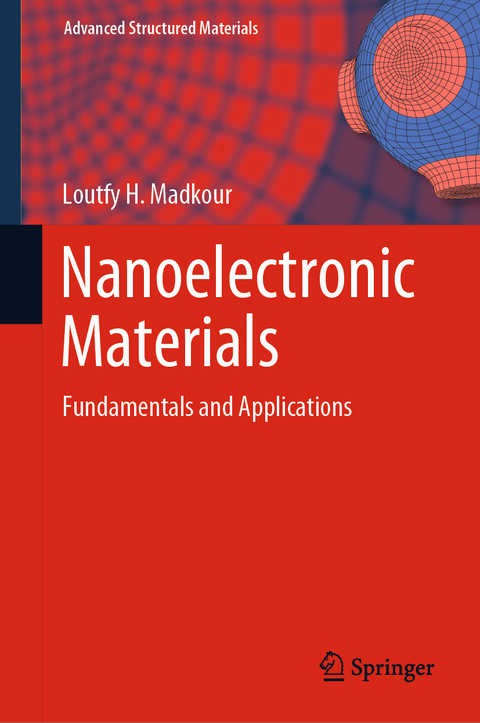
Nanoelectronic Materials
Springer International Publishing (Verlag)
978-3-030-21620-7 (ISBN)
This book presents synthesis techniques for the preparation of low-dimensional nanomaterials including 0D (quantum dots), 1D (nanowires, nanotubes) and 2D (thin films, few layers), as well as their potential applications in nanoelectronic systems. It focuses on the size effects involved in the transition from bulk materials to nanomaterials; the electronic properties of nanoscale devices; and different classes of nanomaterials from microelectronics to nanoelectronics, to molecular electronics. Furthermore, it demonstrates the structural stability, physical, chemical, magnetic, optical, electrical, thermal, electronic and mechanical properties of the nanomaterials. Subsequent chapters address their characterization, fabrication techniques from lab-scale to mass production, and functionality.
In turn, the book considers the environmental impact of nanotechnology and novel applications in the mechanical industries, energy harvesting, clean energy, manufacturing materials,electronics, transistors, health and medical therapy. In closing, it addresses the combination of biological systems with nanoelectronics and highlights examples of nanoelectronic-cell interfaces and other advanced medical applications.
The book answers the following questions:
- What is different at the nanoscale?
- What is new about nanoscience?
- What are nanomaterials (NMs)?- What are the fundamental issues in nanomaterials?
- Where are nanomaterials found?
- What nanomaterials exist in nature?- What is the importance of NMs in our lives?
- Why so much interest in nanomaterials?
- What is at nanoscale in nanomaterials?- What is graphene?
- Are pure low-dimensional systems interesting and worth pursuing?
- Are nanotechnology products currently available?- What are sensors?
- How can Artificial Intelligence (AI) and nanotechnology work together?
- What are the recent advances in nanoelectronic materials?- What are the latest applications of NMs?
Dr. LOUTFY H. MADKOUR has been a Professor of Physical Chemistry and Nano Science at the Department of Chemistry, Faculty of Science, Al Baha University, Saudi Arabia, since 2012. He received his B.Sc., M.Sc. and Ph.D. in Physical Chemistry from Cairo University, Minia University and Tanta University (Egypt), respectively. He began working as a Lecturer in Chemistry at Tanta University in 1982 and as a Professor of Physical Chemistry in 1999. He has conducted a series of studies in the fields of electrochemistry, corrosion science, density functional theory, molecular dynamic simulation, nanoscience, nanotechnology, nanomedicine, analytical chemistry, polarography, electrolytic extraction of heavy metals from natural ores and deposits, electrochemical thermodynamics and environmental chemistry. His previous research accomplishments include the biosynthesis of metallic nanoparticles (MNPs) and toxicology studies for pharmacological applications in medicine and therapy. He has published 150 peer-reviewed original research articles, 11 review articles, and 4 books on physical chemistry, practical and applied chemistry, corrosion science, nanoscience and nanomedicine. Prof. Madkour is an Editorial Board member for several international journals, e.g. the International Journal of Industrial Chemistry (IJIC); International Journal of Ground Sediment & Water; Global Drugs and Therapeutics (GDT); Journal of Targeted Drug Delivery; Journal of Clinical and Medical Research; and International Journal of Environmental Chemistry. In addition to serving as a Reviewer for many international ELSEVIER and SPRINGER journals, he is a member of many prestigious international societies, including the American Association for the Advancement of Science (AAAS), European Desalination Society (EDS), Egyptian Chemical Society (ECS), Egyptian Corrosion Bulletin Society and American Chemical Society (ACS).
Introduction to Nanotechnology (Nt) and Nanomaterials (Nms).- Principles of Computational Simulations Devices and Characterization of Nanoelectronic Materials.- Where are Nanomaterials (Nms) Found.- Benefits of Nanomaterials and Nanowire Geometry.- Why So Much Interest in Nanomaterials (Nms).- Examples of Nanomaterials With Various Morphologies.- Carbon Nanomaterials and Two-Dimensional Transition Metal Dichalcogenides (2d Tmdcs).- Nanoelectronics and Role of Surfaces Interfaces.- Classification of Nanostructured Materials.- Processing of Nanomaterials (Nms).- Techniques for Elaboration of Nanomaterials.- Synthesis Methods for 2d Nanostructured Materials, Nanoparticles (Nps), Nanotubes (Nts) and Nanowires (Nws).- Chemistry and Physics for Nanostructures Semiconductivity.- Roperties of Nanostructured Materials (Nsms) and Physicochemical Properties of (Nps).- Applications of Nanomaterials and Nanoparticles.- Environmental Impact of Nanotechnology and Novel Applications of Nano Materialsand Nano Devices.- Interfacing Biology Systems with Nanoelectronics.- Future Perspectives.- Conclusions.
| Erscheinungsdatum | 18.07.2019 |
|---|---|
| Reihe/Serie | Advanced Structured Materials |
| Zusatzinfo | XLV, 783 p. 669 illus., 543 illus. in color. |
| Verlagsort | Cham |
| Sprache | englisch |
| Maße | 155 x 235 mm |
| Gewicht | 1406 g |
| Themenwelt | Technik ► Elektrotechnik / Energietechnik |
| Technik ► Maschinenbau | |
| Schlagworte | Materials Science • nanobiotechnology • nanochemistry • Nanocrystals • Nanoelectronic Materials • nanomaterials • nanomedicine • Nanoscience • nanotechnology • Quantum dots |
| ISBN-10 | 3-030-21620-9 / 3030216209 |
| ISBN-13 | 978-3-030-21620-7 / 9783030216207 |
| Zustand | Neuware |
| Haben Sie eine Frage zum Produkt? |
aus dem Bereich


